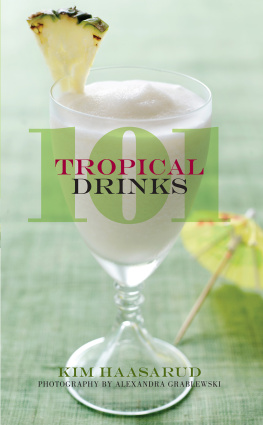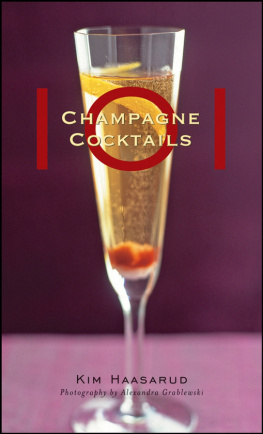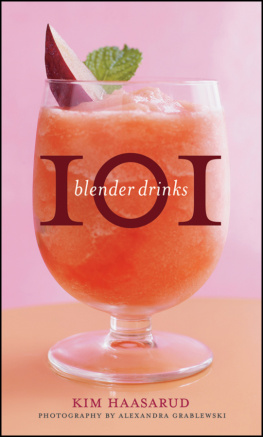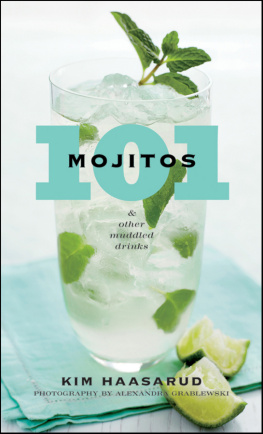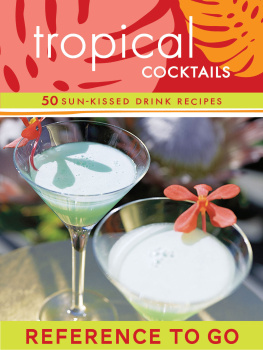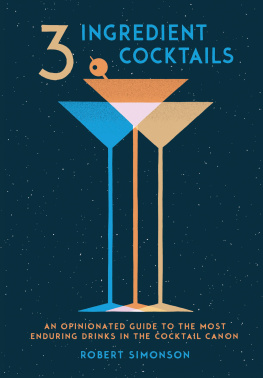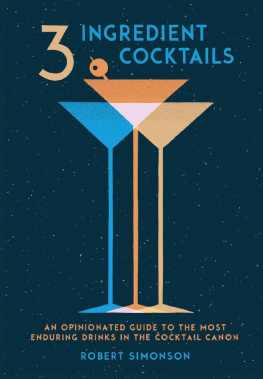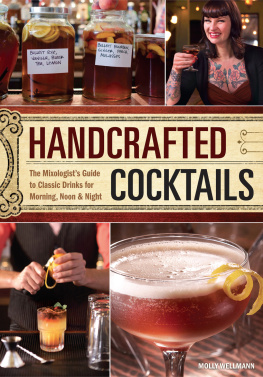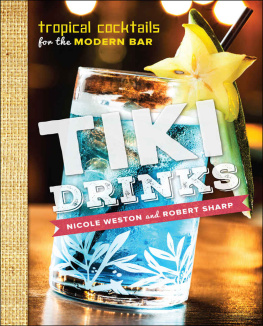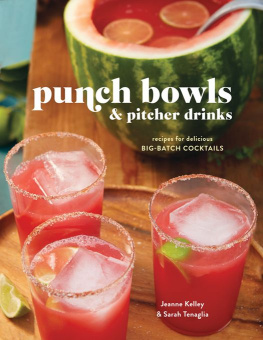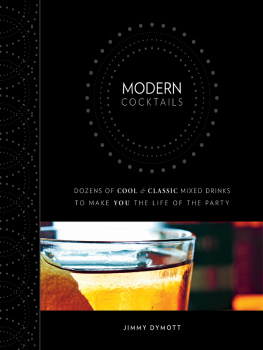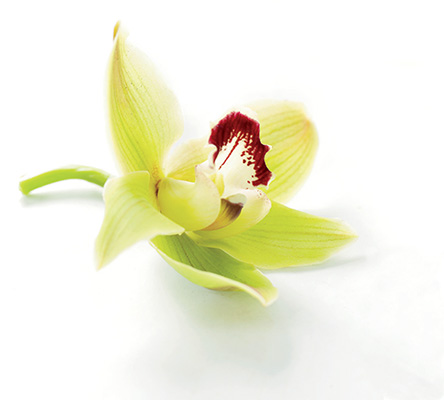Copyright 2013 by Kim Haasarud.
All rights reserved.
Photography 2013 by Alexandra Grablewski
Food styling by Brian Preston-Campbell
Prop styling by Martha Bernabe
For information about permission to reproduce selections from this book, write to Permissions, Houghton Mifflin Harcourt Publishing Company, 215 Park Avenue South, New York, New York 10003.
www.hmhbooks.com
Library of Congress Cataloging-in-Publication Data
Haasarud, Kim.
101 Tropical Drinks / Kim Haasarud ; photography by Alexandra Grablewski.
1 online resource.
Description based on print version record and CIP data provided by publisher; resource not viewed.
ISBN 978-1-118-45675-0 (cloth : acid-free paper) -- ISBN 978-0-544-18930-0 (ebook) I. Drinks. I. Title. II. Title: One hundred one tropical drinks. III. Title: One hundred and one tropical drinks.
TX951
641.874--dc23
2012035716
v2.0513
Introduction
T he tropical cocktail conjures exotic visions of swaying palm trees, white sandy beaches, gentle ocean breezes, and libations served from hollowed-out pineapples. Add to that the tastes of coconut, guava, ginger, and copious amounts of rum and you begin to get the picture. But lest we forget, tropical is a kindred spirit to tiki. And when we mention tiki, we have to pay homage to our founding fathers: Vic Bergeron of the legendary Trader Vics and Don the Beachcomber.
Back in the 1940s, Americans were smitten with the lure of the South Pacificit was exotic, it was adventurous, it was fun. Cmon, who wouldnt find shrunken heads, pirates, Hollywood icons frolicking in the sand, and fire-lit punchbowls exciting? It was just after the Depression and while most Americans couldnt afford to travel, they could indulge their thirst for adventure in some tiki cocktails. Back then, tiki cocktails were treasured proprietary drinks, with barmen guarding their recipes by writing them in code. They used many different rums, and concocted their own homemade syrups and liqueurs. Unfortunately, tiki cocktails suffered much like many of their classic cocktail brethren; fresh juices were replaced by bottled mixes, and classic rums were replaced by cheap impersonators. But now thanks to the tireless efforts of tiki historians and experts like Jeff Beachbum Berry, many of these original recipes have been rediscovered, and as a result the tiki movement is alive and well once again. Witness the opening in the past few years of great new tiki bars around the country, establishments like Smugglers Cove in San Francisco; Forbidden Island in Alameda, California; and Painkiller NY and Lani Kai in New York City just a few that would make Vic and Don proud.
In this book, Ive included many classic tropical and tiki cocktails (thank you, Jeff Berry) as well as some reimagined ones. Ive also taken liberty with some classic cocktails like the Cosmopolitan and Margarita and given them a contemporary tropical spin. Tropical and tiki drinks can run the gamut from super easy to make with a quick shake of a few ingredients to more involved productions requiring the layering of different rums, swizzling, blending in a blender, making your own syrups, using bitters, infusing, and so on. In this introduction Ive listed many different rums and their island characteristics, as well as liqueurs, other spirits, purees, bitters, juices, and more. But the whole point of a tiki drink is for it to be a little exotic with a whole lot of flavorno stress.
So grab a good bottle of rum, flip through this book, and pick a drink that tickles your fancy and ignites your sense of adventure. Oh, and dont forget to raise a glass to the spirits of Vic and Don.
Kim Haasarud
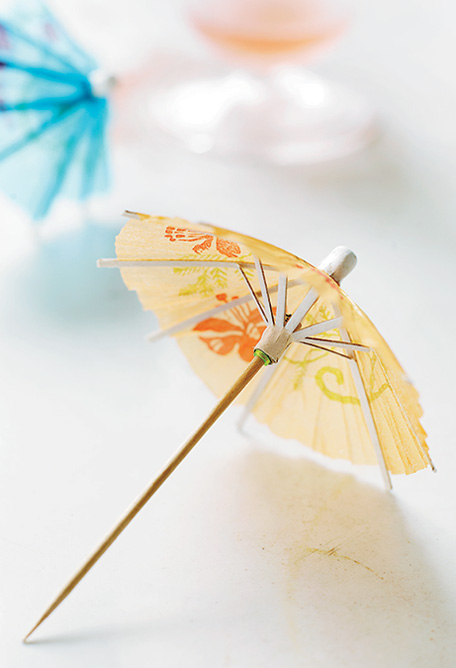
THE RUMS
U nlike any other spirit category, rums play in the sandbox really well. Meaning you can layer and mix them for added depth and flavor. While rums originated in the South Pacific (hence the reason they are so readily used in tropical and tiki drinks), they can be made anywhere in the world; the only restriction is that sugar cane is involved. The majority of rums are made from molasses, a by-product of making sugar. Others, however, are made straight from sugar cane juice. Below, Ive listed rums by style and region to give you a better and bigger picture of how rums are made, classified, and characterized.
STYLES
WHITE/SILVER RUM. Usually clear. Most white and silver rums are aged, but are further distilled and filtered to remove the color. Great mixability.
GOLD/AMBER RUM. Light gold or amber. Usually aged for a few years. No regulation on how long it must be aged.
DARK RUM. Full bodied and darker in color. Quite a few are produced from pot stills and aged in oak. No regulation on how long it must be aged.
AGRICOLE RHUM. Appellation Controlee from Martinique, in the French West Indies. Made from distilled sugar cane juice. Light with a nice vegetal quality to it; buttery.
SPICED RUMS. A white, gold, or dark rum infused with spices and fruits.
FLAVORED RUMS. Rums (usually white rums) infused with flavors ranging from vanilla to coconut to mango.
ANEJO AND AGE-DATED RUMS. Blended aged rums. Age-dated rums, such as Bacardi 8, usually reflect the youngest aged rum in the blend.
RUM REGIONS
BARBADOS. Produces light and sweetish rums. One of the first regions that really started to put out a soft, smooth rum. Back in the eighteenth century, rum was well known as a fiery, almost unpalatable spirit. Barbados put rum on the map as a fine spirit. (George Washington actually requested a Barbados rum for his inaugurationthat was the good stuff.) Current examples include Mount Gay and Foursquare.
CUBA. Light-bodied and crisp. One of the first regions yielding a very soft and smooth rum. Many rum connoisseurs associate Cuban rums (the predecessor to Puerto Rican rums) with being much like the rum version of a vodka: fairly neutral and smooth. Examples include Havana Club and Bacardi, established in Cuba, since moved to Puerto Rico.
DOMINICAN REPUBLIC. Full-bodied, aged rums from column stills. Examples include Ron Matusalem and Brugal.
GUYANA. Rich, heavy, Demerara rums aged for long periods of time (25 years), often blended with lighter rums. Examples include El Dorado.
HAITI. Full-bodied rums. Aged in oak casks three or more years. Examples include Rhum Barbancourt.
JAMAICA. Rich and aromatic. Some can be funky, wild, and rich and others soft and smooth. Examples include Myers, Appleton Estate, and Wray & Nephew.
MARTINIQUE. Contains the largest number of rum distilleries in the eastern Caribbean. Mostly agricole rhums. Often aged in French brandy casks three or more years. One significant factor about rums from this island is that they were awarded the prestigious French label appellation dorigine controlee , previously reserved only for wines and cheeses. Rums from this region can only be called rhums . Because the majority of these rhums are agricole, they are light, somewhat vegetal, and even buttery. Examples include Neisson Rhum Agricole.
PUERTO RICO. One of the biggest producers of rum. The white rums are known to be very smooth and even a somewhat neutral spirit. Very mixable. Examples include Bacardi, Ron de Barrilito, and Don Q.
TRINIDAD. Primarily light rums. Examples include 10 Cane and Angostura.

